With her contorted postures and disdainful expression, the fascinating and enigmatic Pina Menichelli (1890-1984) was the most bizarre diva of the Italian silent film.
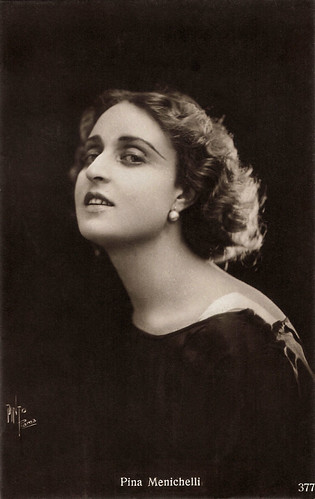
Italian postcard by Ed. A. Traldi, Milano, no. 377. Photo: Pinto, Roma.
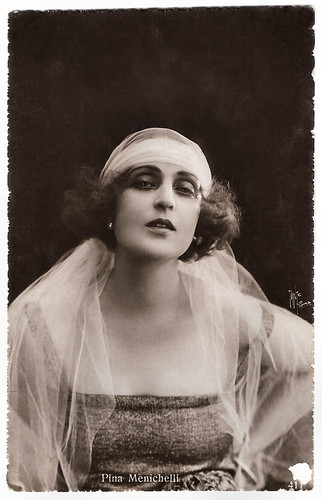
Italian postcard by Ed. A. Traldi, Milano, no. 411. Photo Pinto, Roma.
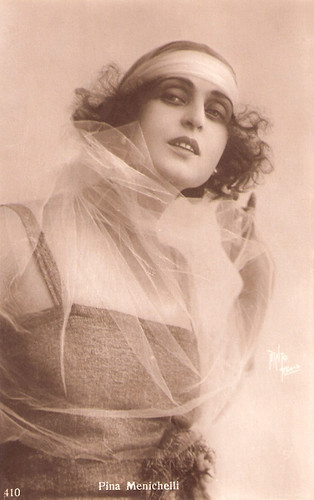
Italian postcard by Ed. A. Traldi, Milano (Milan), no. 410. Photo: Pinto.
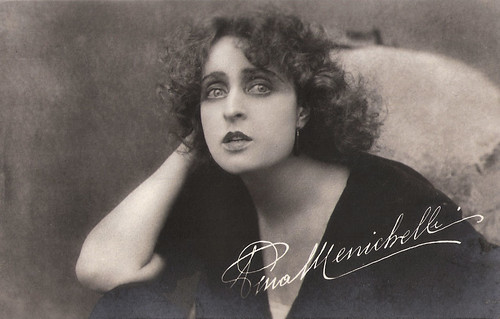
French postcard by BPA, Rueil.
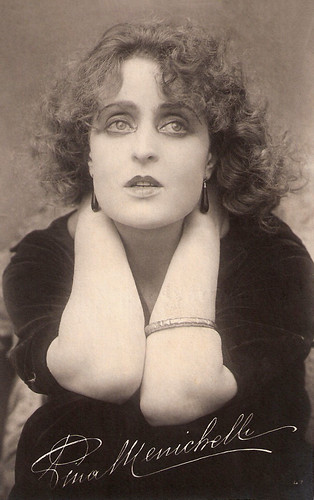
Italian postcard, no. 47.
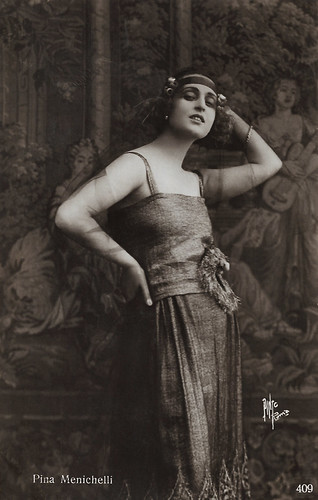
Italian postcard by Ed. A. Traldi, Milano, no. 409. Photo: Pinto, Roma.
Notre Dame des Spasmes
Giuseppina Menichelli was born in Castroreale, Italy, in 1890. She was the sister of singer and actress Dora Menichelli.
After starting her film career at the Roman Cines company in 1913, Pina was catapulted into stardom by Giovanni Pastrone's D'Annunzian film Il Fuoco/The Fire (1915) co-starring with Febo Mari. Il Fuoco tells the love story of a young, vulnerable painter and a wealthy woman. The film's erotic atmosphere caused it to be banned and prompted clerical demonstrations against the film.
Because of her femme fatale, men devouring type, and her extreme and sudden gestures she was nicknamed 'Notre Dame des Spasmes'. Menichelli did however know how to play also in a more restrained way, as Tigre Reale/Royal Tiger (Giovanni Pastrone, 1916) showed.
The script was based on a book by Giovanni Verga and was scripted by the author himself. Verga was a Sicilian writer known for his realist (verismo) fiction rather than for his symbolist-decadent works. Despite this, the story of Tigre Reale is a melodrama, full of unlikely twists and turns, but the public was held, mesmerised, by the fascinating and enigmatic Menichelli.

Spanish postcard. Photo: Itala-Film. Pina Menichelli and Febo Mari in Il Fuoco/The Fire (Giovanni Pastrone, 1915). Collection: Marlene Pilaete. Please note that Menichelli wears her famous owl headwear here.
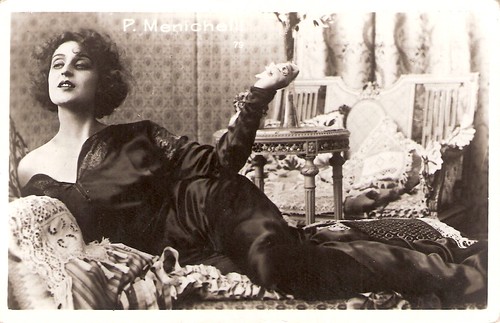
Italian postcard by Ed. Vettori, Bologna. Photo: Pina Menichelli in Tigre Reale (Giovanni Pastrone, 1916).
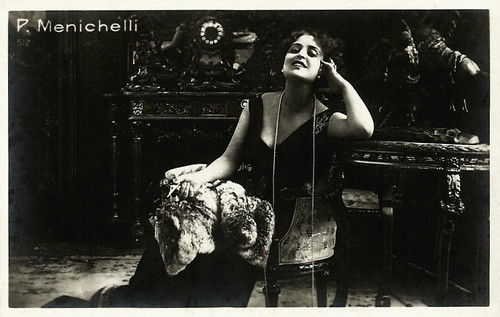
Italian postcard. Photo: Pina Menichelli in Tigre reale (Giovanni Pastrone, 1916).
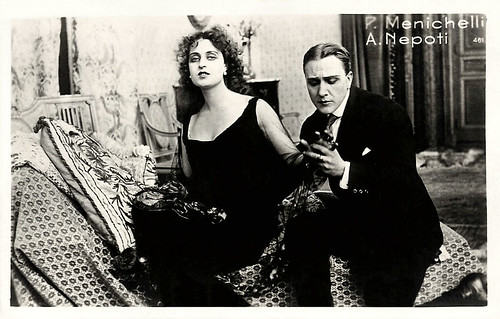
Italian postcard by Vettori, Bologna, no. 461. Pina Menichelli and Alberto Nepoti, probably in Tigre reale (Giovanni Pastrone, 1916).

Spanish postcard. Photo: Pina Menichelli in L'olocausto/Méche d'or/Gold Plait (Gero Zambuto, 1918). Collection: Marlène Pilaete.
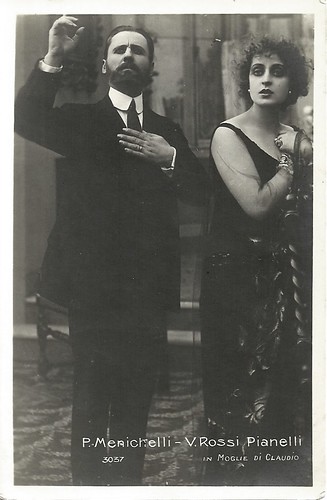
Italian postcard, no. 3037. Photo: Itala. Pina Menichelli and Vittorio Rossi-Pianelli in La moglie di Claudio (Gero Zambuto, 1918), based on 'La femme de Claude' by Alexandre Dumas fils. The film was found and restored in 2011 by Museo nazionale del cinema in Turin and Cineteca di Bologna. See Vimeo.com.
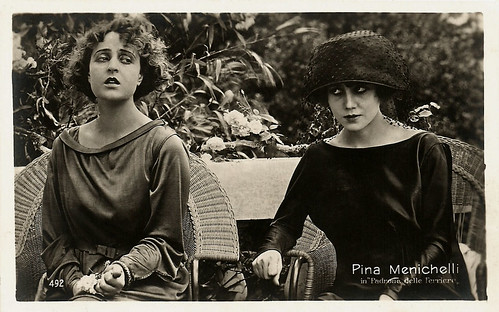
Italian postcard by Vettori, Bologna. Photo: Pina Menichelli in Il padrone delle ferriere (Eugenio Perego, 1919). The other actress must be Lina Millefleurs.

Italian postcard by Ed. Vettori, Bologna, no. 1038. Pina Menichelli and Luigi Serventi in Il romanzo di un giovane povero (Amleto Palermi, 1920), based on the novel 'Le Roman d'un jeune homme pauvre' (1858) by Octave Feuillet.
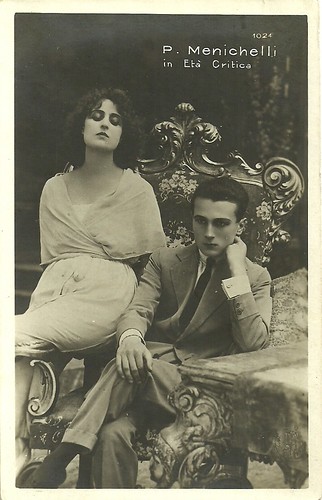
Italian postcard by Ed. Vettori, Bologna, no. 1024. Pina Menichelli and Giorgio Fini in the Italian silent film L'età critica (Amleto Palermi, 1921). Her co-stars were Livio Pavanelli, Giorgio Fini and Gemma De Ferrari. The film was based on the play by Max Dreyer, 'Die Siebzehnjährigen' (1904).
The Letter
La dama de chez Maxim's (Amleto Palermi, 1923) was one of Pina Menichelli's last films. With this film and with Occupati d'Amelia (Telemaco Ruggeri, 1925), both adaptations of French boulevard comedies by Georges Feydeau, Menichelli proved she was well able to do comedy and not only melodramatic and 'vampy' films. In both films, one of her co-stars was the French comedian Marcel Lévesque, on the far right on the card below.
After these comedies, however, Pina Menichelli withdrew from the cinema and held back any attempt to interview her.
Pina Menichelli died in 1984 in Milan at the age of 94. Fifteen years later she was one of the divas featured in Diva Dolorosa (Peter Delpeut, 1999), a montage of scenes featuring silent cinema divas, taken from 12 European films made between 1913 and 1920.
In her fascinating, ironic text, Short Manual for the Aspiring Scenario Writer, the French author Colette gave a typical description of the femme fatale in cinema, largely based on Pina Menichelli.
Talking about the 'arms' of the femme fatale Colette indicates the hat and the rising gorge: "The femme fatale' s hat spares her the necessity, at the absolute apex of her wicked career, of having to expend herself in pantomime. When the spectator sees the evil woman coiffing herself with a spread-winged owl, the head of a stuffed jaguar, a bifid aigrette, or a hairy spider, he no longer has any doubts; he knows just what she is capable of. And the rising gorge? The rising gorge is the imposing and ultimate means by which the evil woman informs the audience that she is about to weep, that she is hesitating on the brink of crime, that she is struggling against steely necessity, or that the police have gotten their hands on the letter. What letter? THE letter."
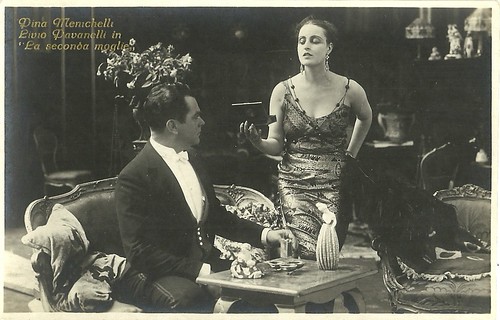
Italian postcard by Edizione G.B. Falci, no. 262. Photo: Pina Menichelli and Livio Pavanelli in La seconda moglie (Amleto Palermi, 1922).
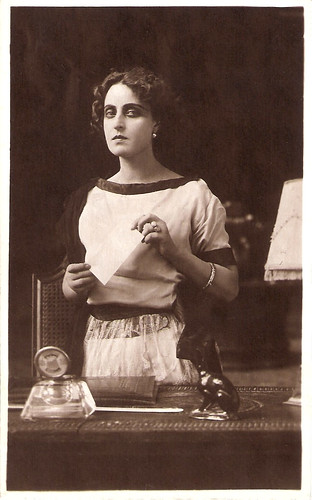
Italian postcard by Rinascimento Film, Roma. Photo: Pina Menichelli in La seconda moglie (Amleto Palermi, 1922).
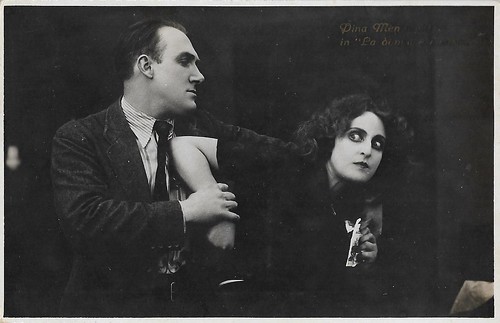
Italian postcard by Ed. G.B. Falci, Milano. Pina Menichelli and Milton Rosmer in La donna e l'uomo (Amleto Palermi, 1923), produced by Rinascimento Film and distributed by UCI.

Italian postcard by G.B. Falci, Milano Milan. Pina Menichelli in La biondina (Amleto Palermi, 1923), based on a book by Marco Praga. It tells the tragedy of a woman whose husband kills her in the end. It seems that Italian censorship forced the scriptwriter to add morality to the film, so Praga's tragedy is framed within a story about a modest, conventional wife who, encouraged by her friend, dreams of breaking out, but then she reads Praga's book and decides to remain honest and loyal. The actress on the left of the card could be the friend (Gemma de' Ferrari).

Italian postcard by G.B. Falci, Milano. Photo: Fotominio. Pina Menichelli and Giovanni Grasso in Malafemmina, a title unknown to IMDb, but it is the alternative title of L' ospite sconosciuta/The Unknown Guest (Telemaco Ruggeri, 1923).
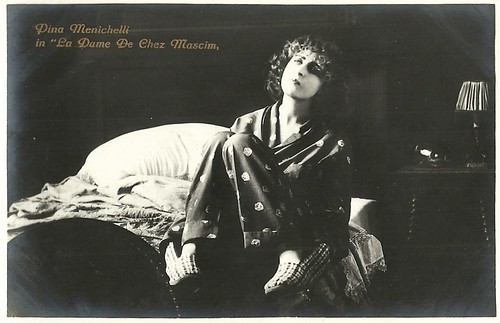
Italian postcard by G.B. Falci, Milano. Photo: Pina Menichelli in her last film La dama de Chez Maxim (Amleto Palermi, 1923). Menichelli played the legendary Môme Crevette in one of the many film adaptations of Georges Feydeau's classic boulevard comedy.

Italian postcard. Photo: G.B. Falci, Milano. Publicity still for La dama de chez Maxim's (1923) with Marcel Lévesque at far right.
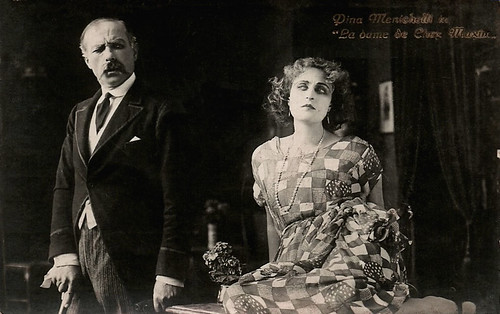
Italian postcard. Photo: G.B. Falci, Milano. Publicity still for La dama de chez Maxim's (1923).
Sources: Vittorio Martinelli (Le dive del silenzio), Greta de Groat (Unsung Divas of the Silent Screen), Il Cinema Ritrovato 2015 and IMDb.
This comment has been removed by a blog administrator.
ReplyDelete